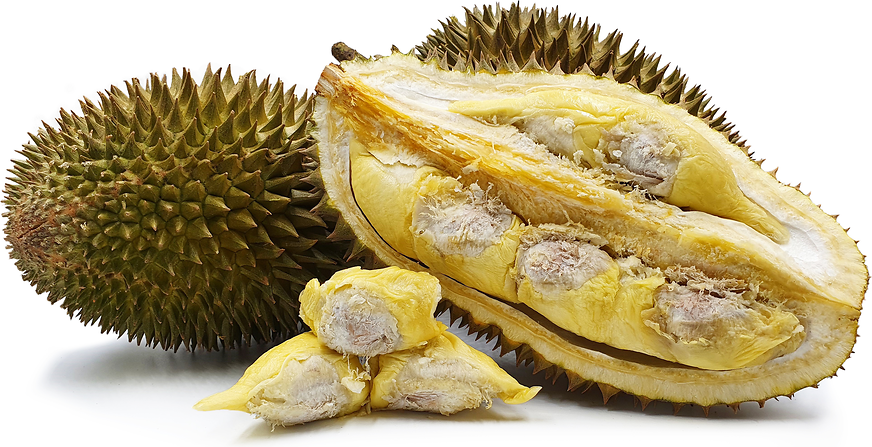


Tembaga Durian
Estimated Inventory, lb : 0
Description/Taste
Tembaga durians are medium to large fruits, averaging 10 to 25 centimeters in length, and have an oval to oblong shape, covered in broad, stiff, and angular spikes. The tough, pointed thorns have five distinct sides and range in color from pale green, brown, to gold. Underneath the spikes, there is a thick, fibrous, and spongy white pith that can be torn open to reveal multiple lobes of bright yellow-orange flesh. The flesh is smooth, slippery, and thick with a soft consistency, encasing a few small, flattened seeds within each lobe. Tembaga durians have a rich, complex flavor comprised of sweet, bitter, pungent, tannic, and nutty notes.
Seasons/Availability
Tembaga durians are available during the southwest monsoon season in Southeast Asia, which is the same time as summer in North America.
Current Facts
Tembaga durians, botanically classified as Durio zibethinus, are rare fruits with a distinct, bitter-sweet flavor, belonging to the Malvaceae family. The name Tembaga translates from Indonesian to mean “copper,” and this descriptor was given in reference to the fruit’s flesh coloring. Tembaga durians are an official clone, registered through the Malaysian Department of Agriculture under the name D118, and were created through bud-grating and other specific breeding practices. Over 199 clones have been registered with the Malaysian Department of Agriculture since 1934, and Tembaga was recorded in 1970, exhibiting improved growth characteristics from other durian varieties. In markets across Indonesia and Malaysia, Tembaga durians are favored for their unique flavoring, thick flesh, and small seeds, but outside of these regions, the clone remains mostly unknown to the rest of the world. In the present-day, Tembaga durians are being cultivated in specific regions of Indonesia in hopes of marketing the fruits to become a new, in-demand variety. Tembaga durian trees are also being advertised as a suitable home garden variety, as one tree can produce hundreds of fruits per season.
Nutritional Value
Tembaga durians are an excellent source of vitamin C, an antioxidant that reduces inflammation, strengthens the immune system, and increases collagen production within the skin. The fruits are also a good source of fiber to regulate the digestive tract, potassium to balance fluids levels, iron to build protein to carry oxygen in the blood, and contain lower amounts of folate, manganese, copper, iron, calcium, and magnesium.
Applications
Tembaga durians are primarily consumed fresh, out-of-hand, as their thick flesh and bitter flavor are showcased when raw. The slippery, rich flesh can be eaten as a stand-alone snack, or the fruits can be blended into smoothies, sliced and served as a fresh topping over ice cream, mashed and spread on bread, or chopped and mixed into side dishes and condiments. Tembaga durians can also be blended with sugar into a paste-like filling and incorporated into crepes, puff pastries, cakes, and tarts, or the fruits can be used to flavor ice cream. Beyond sweet applications, Tembaga durians can be stirred into curries or lightly fried and served over rice. Tembaga durians pair well with spices such as cinnamon, cardamom, and cloves, fruits such as mango, coconut, banana, passion fruit, and avocados, lemongrass, and chocolate. Whole, unopened Tembaga durians will keep for a couple of weeks when stored in a cool location. Once sliced, the flesh is best consumed immediately for optimal flavor and can be stored for an additional 2 to 3 days in the refrigerator. Durian flesh can also be frozen for up to 2 months.
Ethnic/Cultural Info
Tembaga durians are one of the varieties sold through DurianBB, one of the world’s first durian café chains. The idea for the café was created in 2015 by Adrian Choy in Hong Kong. Durians were often associated with fresh markets, considered an exotic fruit, and were met with polarizing opinions. Despite their pungent nature, Choy came up with an idea to import durians from Malaysia and began hosting catered durian parties in Hong Kong. Choy’s events became so popular that within six months, he opened his first café location in Hong Kong. Since 2015, Choy has opened several other cafes throughout Asia and Southeast Asia, and in 2019, a new DurianBB concept store was opened in Kota Kinabalu, the capital city of Sabah, Malaysia. The concept store featured durian products year-round and was developed to create a unique experience for durian lovers in a metropolitan setting. At the café, fresh durian varieties, including Tembaga durians, are locally sourced and sold in sections, and house-made desserts such as durian ice cream, cheesecake, and mousse are available for purchase. Tembaga durians are also featured on a signature durian tasting platter, showcasing different kinds of durians with labels to allow tasters to distinguish between varietal flavors, colors, and textures. In addition to fresh durian, the DurianBB concept store offers unique durian-flavored souvenirs, such as durian popcorn, egg rolls, durian plush toys, and durian pillows.
Geography/History
Tembaga durians are native to Southeast Asia and were believed to have been created by nursery owner and durian grower Lee Lam Siew in Perak, a state situated along the Malay Peninsula's western coast. The variety was officially registered with the Malaysian Agriculture Office in 1970 under the identification number D118. In the 1990s, Tembaga durians widely increased in popularity for their bitter-sweet flavor, and the variety was planted throughout Malaysia and Indonesia for small-scale production. Today Tembaga durians are found through local growers in Borneo, Sumatra, West Java, and Bangka Island of Indonesia and cities on the Malay Peninsula.

Recipe Ideas
Recipes that include Tembaga Durian. One
| Baking Taitai |
|
Durian Pudding |
| Bisous a Toi |
|
Durian Cotton Cake |
| Grace Kitchen Corner |
|
Durian Mousse Cake |
| The Fussy Palate |
|
Durian Pancakes |
Podcasts



